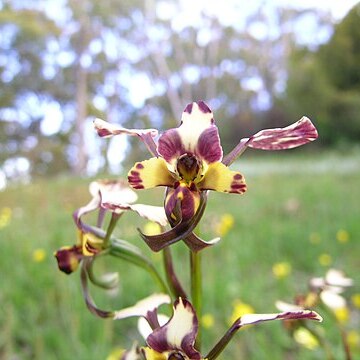Leaves 2 or 3, 80–150 × 3–6 mm, folded. Flower stem 120–300 mm, 1–5-flowered. Flowers, 20–25 mm across, yellow, variably blotched and marked with red-brown. Dorsal sepal incurved to erect, narrowly ovate, 9–12 × 6–8 mm, with 2 large, marginal blotches and smaller marks. Lateral sepals deflexed, crossed, 12–16 × 2–2.5 mm. Petals obliquely erect to recurved; stalk 5–6 mm long, blackish; blade ovate, 10–12 × 7–9 mm. Labellum 5–7 mm long; lateral lobes 5–7 × 3–3.5 mm, widest towards irregular apex; midlobe wedge-shaped, 4–5 × 6–8 mm, shallowly to strongly folded. Callus ridges 2, 3.5–4 mm long, thick.
Leaves 2 or 3, 150–300 × 3–6 mm, folded. Flower stem 200–400 mm, 2–10-flowered. Flowers, 20–25 mm across, pale yellow, heavily blotched and marked with dark red-brown, especially exterior surfaces. Dorsal sepal erect to recurved, 8–12 × 8–10 mm. Lateral sepals deflexed, recurved and crossed, 12–16 × 2–3 mm. Petals obliquely erect to recurved; stalk 5–8 mm long, blackish; blade ovate, 10–12 × 9–12 mm. Labellum 5–7 mm long; lateral lobes 4–7 × 3–5 mm, widest towards rounded apex; midlobe wedge-shaped, 4–6 × 5–7 mm, shallowly to strongly folded. Callus ridges 2, 3.5–4.5 mm long.

